Seat Toledo 2006 COMMUNICATION SYSTEM
Manufacturer: SEAT, Model Year: 2006, Model line: Toledo, Model: Seat Toledo 2006Pages: 30, PDF Size: 0.36 MB
Page 21 of 30
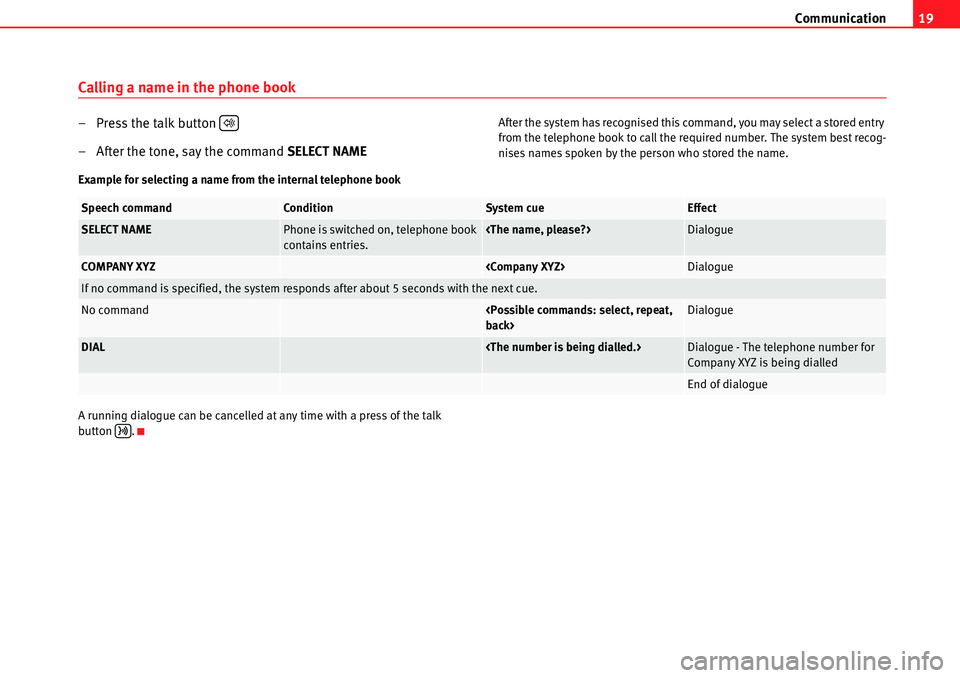
Communication19
Calling a name in the phone book
– Press the talk button
– After the tone, say the command SELECT NAMEAfter the system has recognised this command, you may select a stored entry
from the telephone book to call the required number. The system best recog-
nises names spoken by the person who stored the name.
Example for selecting a name from the internal telephone book
A running dialogue can be cancelled at any time with a press of the talk
button .�.
Speech commandConditionSystem cueEffect
SELECT NAMEPhone is switched on, telephone book
contains entries.
COMPANY XYZ
If no command is specified, the system responds after about 5 seconds with the next cue.
No command
DIAL
Company XYZ is being dialled
End of dialogue
�
Page 22 of 30

Communication
20
Listening to the phone book
You can have the entries stored in the internal telephone book read out to you.
– Press the talk button . The beep tone indicates that the
system is ready.
– Say the command PLAY PHONE BOOK.After giving the command the system will read out the entries stored in the
phone book. Press the talk button as an entry is being read to dial the
telephone number for that entry. Once the dialogue is complete and the
system is reactivated, you can also select an entry to call by specifying the
stored name.
Example for the PLAY PHONE BOOK command:
Example for selecting an entry:
To erase names from the phone book
You can delete entries from the internal telephone book.
– Press the talk button . The beep tone indicates that the system is ready.
– After the tone, say the command DELETE NAME.After giving this command you can delete a stored entry from the internal tele-
phone book.
�.�
Speech commandConditionSystem cueEffect
PLAY PHONE BOOKThe telephone book contains entries.The telephone book will then be read
out.
End of dialogue
Speech commandConditionSystem cueEffect
PLAY PHONE BOOKThe telephone book contains entries;
the talk button is pressed as the
entry is being read out.
The telephone number will be dialled.
End of dialogue
�
�.
Page 23 of 30
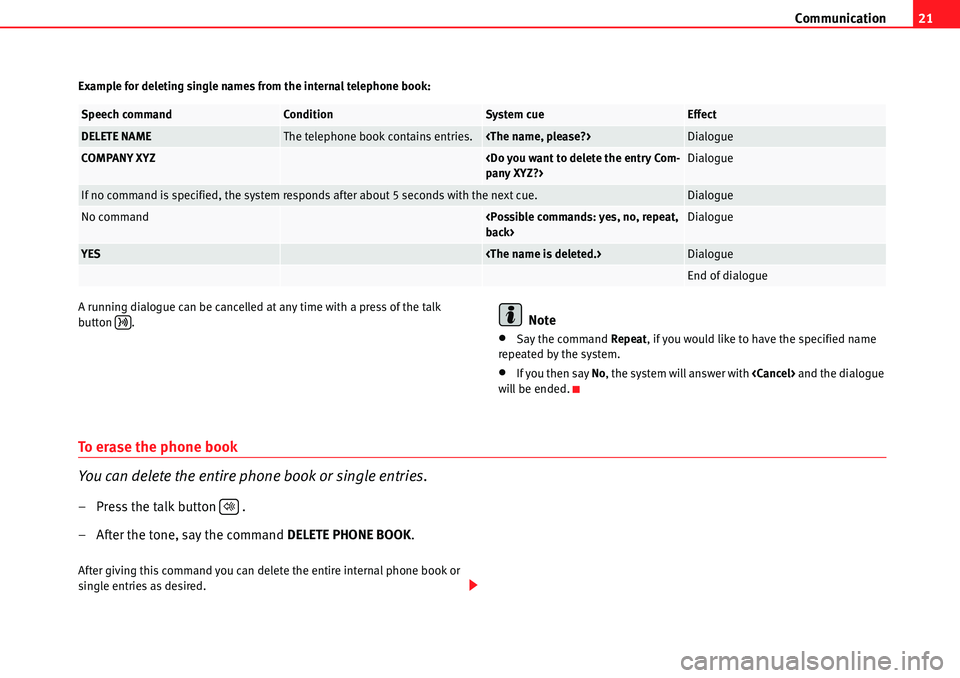
Communication21
Example for deleting single names from the internal telephone book:
A running dialogue can be cancelled at any time with a press of the talk
button .
Note
•Say the command Repeat, if you would like to have the specified name
repeated by the system.
•If you then say No, the system will answer with
will be ended.
To erase the phone book
You can delete the entire phone book or single entries.
– Press the talk button .
– After the tone, say the command DELETE PHONE BOOK.
After giving this command you can delete the entire internal phone book or
single entries as desired.
Speech commandConditionSystem cueEffect
DELETE NAMEThe telephone book contains entries.
COMPANY XYZ
If no command is specified, the system responds after about 5 seconds with the next cue.Dialogue
No command
YES
End of dialogue
�
�.
Page 24 of 30
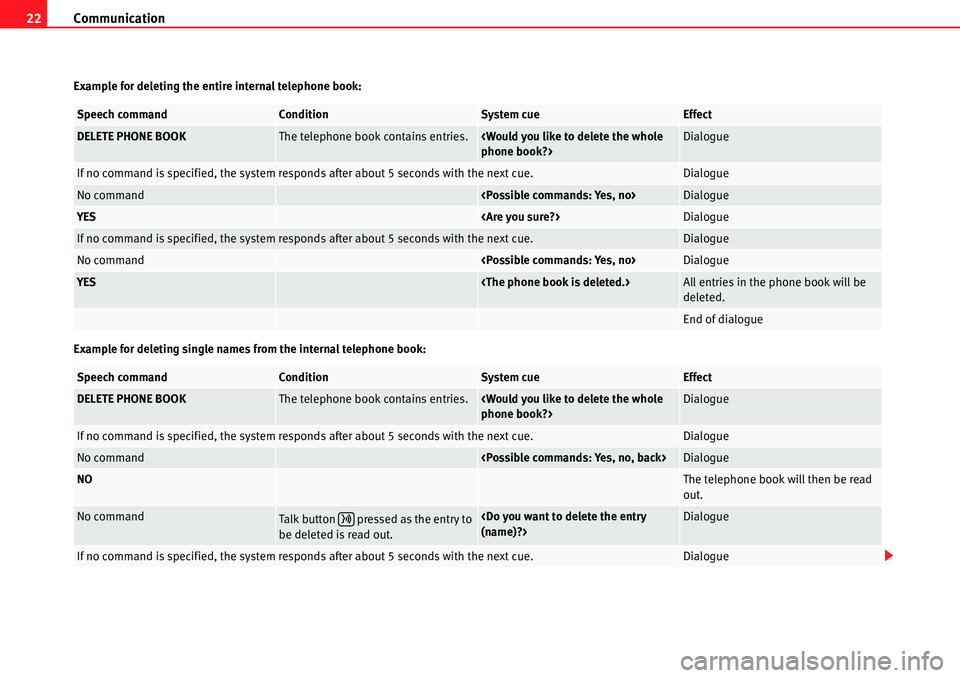
Communication
22
Example for deleting the entire internal telephone book:
Example for deleting single names from the internal telephone book:
Speech commandConditionSystem cueEffect
DELETE PHONE BOOKThe telephone book contains entries.
If no command is specified, the system responds after about 5 seconds with the next cue.Dialogue
No command
YES
If no command is specified, the system responds after about 5 seconds with the next cue.Dialogue
No command
YES
deleted.
End of dialogue
Speech commandConditionSystem cueEffect
DELETE PHONE BOOKThe telephone book contains entries.
If no command is specified, the system responds after about 5 seconds with the next cue.Dialogue
No command
NOThe telephone book will then be read
out.
No commandTalk button pressed as the entry to
be deleted is read out.
If no command is specified, the system responds after about 5 seconds with the next cue.Dialogue
�
Page 25 of 30

Communication23
Notes on the phone book
Take note of these tips and suggestions when using the
phone book.
•It is important that names stored in the phone book have a noticeable
acoustic difference between them so the system can recognise the entries.
•In the event that an telephone book entry is not recognised (e.g. if
someone else tries to call-up a name), the phone book entries can be read out
by giving the command PLAY PHONE BOOK.
•The numbers zero to nine are recognised by the system. Say the numbers
clearly so that the system can recognise them easily. Should the system say
hands-free system as follows.
•Is the phone switched on?
•Has the PIN code been entered?
WARNING
The speech system must not be used in cases of emergency, since the voice
changes in stressful situations. This could result in a failed or delayed tele-
phone connection. For this reason, always enter emergency numbers
manually.
International calls
Country and area codes can be entered as follows.
Notes on entering telephone numbers for calls abroad:
•When making a call abroad, you can say Plus (+) before specifying the
digits.
•After the Plus (+) the country code must be specified. The country code
follows the conventional format (e.g. 49 for Germany or 44 for Great Britain.
•After the country code, the zero (0) should be left out before the area
code.
No command
YES
remaining entries will be read out.
All entries are read out.End of dialogue
Page 26 of 30

Communication
24
Example for making a call to Great Britain:
Bluetooth®
Bluetooth technology enables wireless connections between
mobile and fixed devices without the need for cables.
Mobile communication and information is gaining ever greater importance
for personal use as well as in today's modern business world.
Information transfer between mobile devices up until recently was only
possible through wired and infrared connections.
These non-standardised connections greatly limited the range of use and
were very complicated to operate.
For this reason, the introduction of the Bluetooth® technology represents a
great change, allowing the establishment of a standardised remote connec-
tion between mobile devices from different manufacturers.
WARNING
The Bluetooth function must be switched off during air travel (please refer
to the phone manual).
Note
Certain software version of some mobile telephones contain errors or limited
functions (for example “Download phone book”). These errors may give rise
to faulty operation of the vehicle hands-free system. In this case, consult the
Authorised Service Centre for your mobile telephone.
Bluetooth® configuration
Before using the functionality of the Bluetooth connection
between the mobile telephone and the hands-free system for
the first time configuration of the connection is required.
It will be necessary that the hands-free system and the mobile telephone
recognise each other. To proceed, first the Bluetooth function on the mobile
telephone must be activated. Then, aft er turning on the ignition, select the
option on the telephone to search for other Bluetooth communication devices
within range, in other words, the hands-free system of the vehicle
(SEAT_UHV). The next step is to select this hands-free system. The complete
Speech commandConditionSystem cueEffect
DIAL NUMBERPhone is switched on.
PLUS, FOUR, FOUR
SEVEN, THREE, ONE
THREE, NINE, TWO
DIAL
End of dialogue
Page 27 of 30
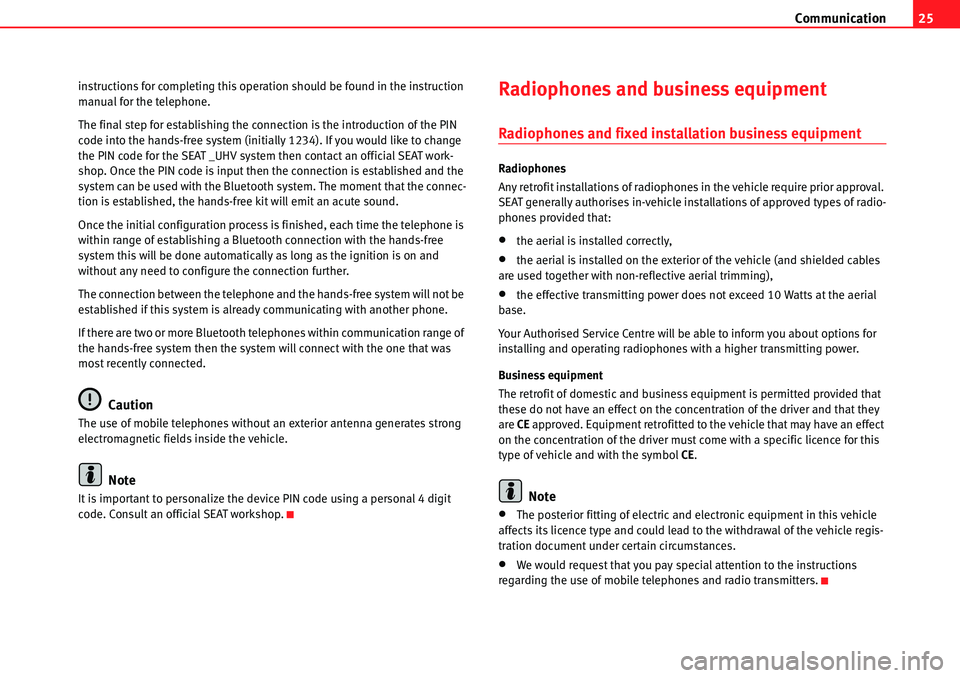
Communication25
instructions for completing this operation should be found in the instruction
manual for the telephone.
The final step for establishing the connection is the introduction of the PIN
code into the hands-free system (initially 1234). If you would like to change
the PIN code for the SEAT _UHV system then contact an official SEAT work-
shop. Once the PIN code is input then the connection is established and the
system can be used with the Bluetooth system. The moment that the connec-
tion is established, the hands-free kit will emit an acute sound.
Once the initial configuration process is finished, each time the telephone is
within range of establishing a Bluetooth connection with the hands-free
system this will be done automatically as long as the ignition is on and
without any need to configure the connection further.
The connection between the telephone and the hands-free system will not be
established if this system is already communicating with another phone.
If there are two or more Bluetooth telephones wi thin communication range of
the hands-free system then the system will connect with the one that was
most recently connected.
Caution
The use of mobile telephones without an exterior antenna generates strong
electromagnetic fields inside the vehicle.
Note
It is important to personalize the device PIN code using a personal 4 digit
code. Consult an official SEAT workshop.
Radiophones and business equipment
Radiophones and fixed installation business equipment
Radiophones
Any retrofit installations of radiophones in the vehicle require prior approval.
SEAT generally authorises in-vehicle installations of approved types of radio-
phones provided that:
•the aerial is installed correctly,
•the aerial is installed on the exterior of the vehicle (and shielded cables
are used together with non-reflective aerial trimming),
•the effective transmitting power does not exceed 10 Watts at the aerial
base.
Your Authorised Service Centre will be able to inform you about options for
installing and operating radiophones with a higher transmitting power.
Business equipment
The retrofit of domestic and business equipment is permitted provided that
these do not have an effect on the concentration of the driver and that they
are CE approved. Equipment retrofitted to the vehicle that may have an effect
on the concentration of the driver must come with a specific licence for this
type of vehicle and with the symbol CE.
Note
•The posterior fitting of electric and electronic equipment in this vehicle
affects its licence type and could lead to the withdrawal of the vehicle regis-
tration document under certain circumstances.
•We would request that you pay special attention to the instructions
regarding the use of mobile te lephones and radio transmitters.
Page 28 of 30
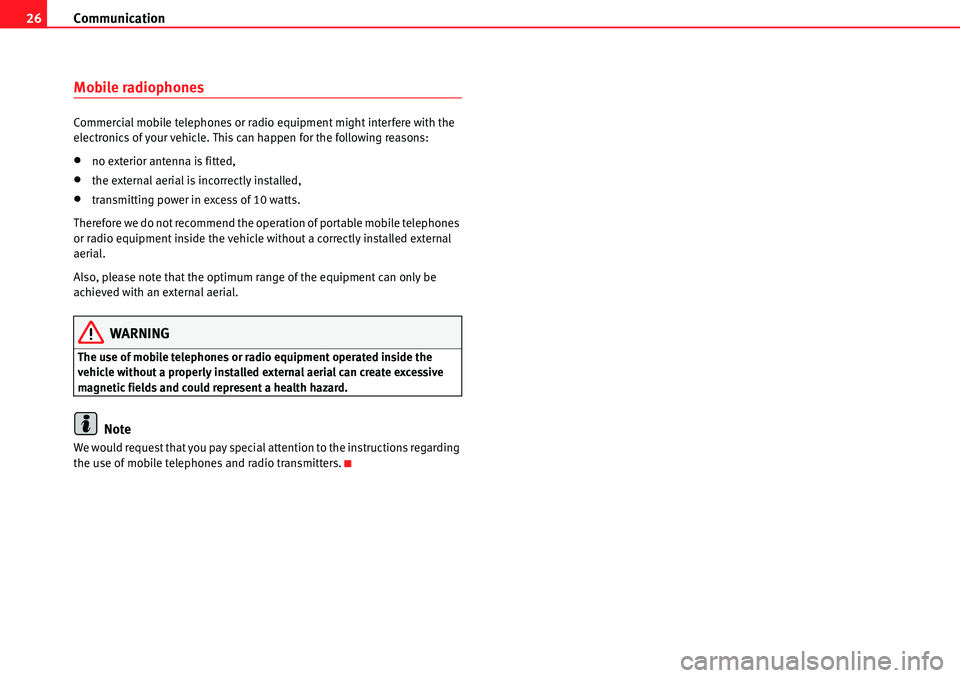
Communication
26
Mobile radiophones
Commercial mobile telephones or radio equipment might interfere with the
electronics of your vehicle. This can happen for the following reasons:
•no exterior antenna is fitted,
•the external aerial is incorrectly installed,
•transmitting power in excess of 10 watts.
Therefore we do not recommend the operation of portable mobile telephones
or radio equipment inside the vehicle without a correctly installed external
aerial.
Also, please note that the optimum range of the equipment can only be
achieved with an external aerial.
WARNING
The use of mobile telephones or radio equipment operated inside the
vehicle without a properly installed external aerial can create excessive
magnetic fields and could represent a health hazard.
Note
We would request that you pay special attention to the instructions regarding
the use of mobile telephones and radio transmitters.
Page 29 of 30

Index27
Index
B
Basic functions . . . . . . . . . . . . . . . . . . . . . . . . . . . 5
Bluetooth® . . . . . . . . . . . . . . . . . . . . . . . . . . . . . 24
Bluetooth® configuration . . . . . . . . . . . . . . . . . . 24
C
Calling a name in the phone book . . . . . . . . . . . 19
Control commands . . . . . . . . . . . . . . . . . . . . . . . 13
Controlling hands-free system from the steering
wheel and multi-function lever . . . . . . . . . . 9
Controlling the hands-free unit by voice . . . . . . 12
D
Dial number . . . . . . . . . . . . . . . . . . . . . . . . . . . . . 16
Dialogue . . . . . . . . . . . . . . . . . . . . . . . . . . . . . . . . 12
F
Fitting the adapter . . . . . . . . . . . . . . . . . . . . . . . . . 6
I
Information on the instrument panel display . . 11
International calls . . . . . . . . . . . . . . . . . . . . . . . . 23
L
Last calls / received calls . . . . . . . . . . . . . . . . . . 10
Listening to the phone book . . . . . . . . . . . . . . . . 20
M
Mobile radiophones . . . . . . . . . . . . . . . . . . . . . . 26
Mobile telephone: inserting into and extracting from the adapter . . . . . . . . . . . . . . . . . . . . . . 7
N
Notes on the phone book . . . . . . . . . . . . . . . . . . 23
P
PIN code input . . . . . . . . . . . . . . . . . . . . . . . . . . . 14
R
Radiophones and fixed installation business equipment . . . . . . . . . . . . . . . . . . . . . . . . . . 25
Redial . . . . . . . . . . . . . . . . . . . . . . . . . . . . . . . . . . 17
Removing the adapter . . . . . . . . . . . . . . . . . . . . . . 8
T
To erase names from the phone book . . . . . . . . 20
To erase the phone book . . . . . . . . . . . . . . . . . . 21 To record names in the phone book . . . . . . . . . . 17
Page 30 of 30

Inglés, Portugués 5P0012006AD (02.06) (GT9)auto emoción